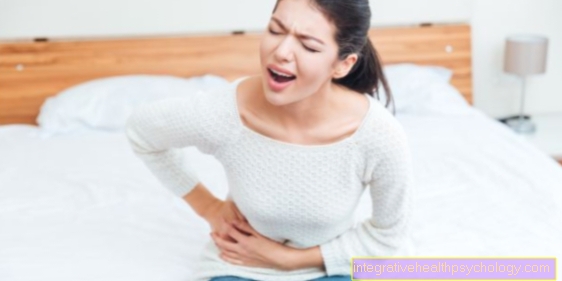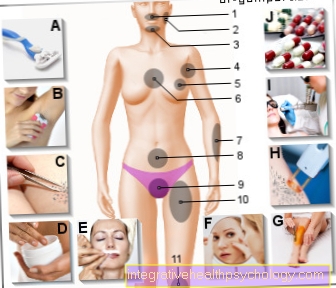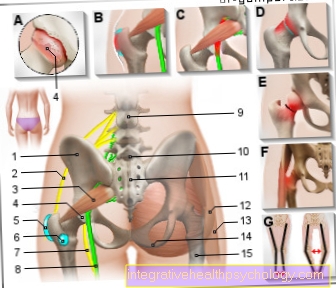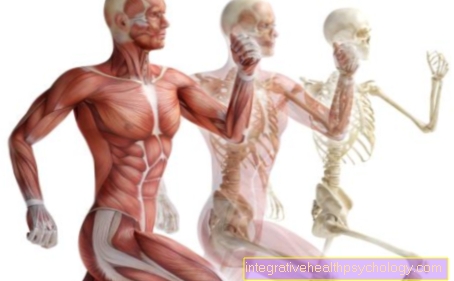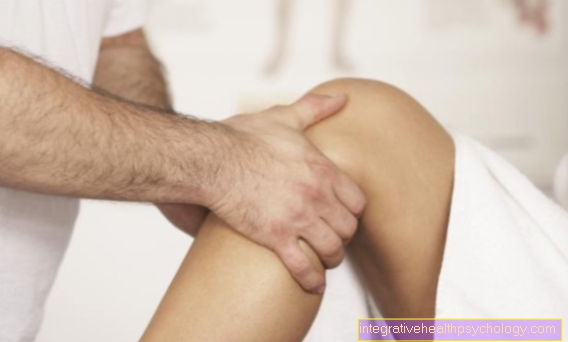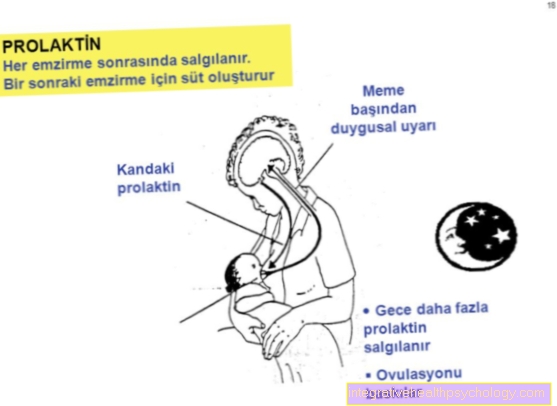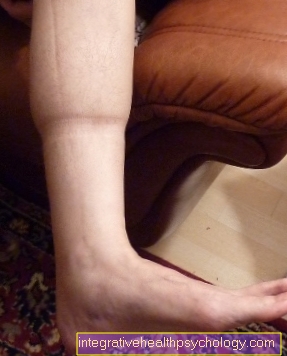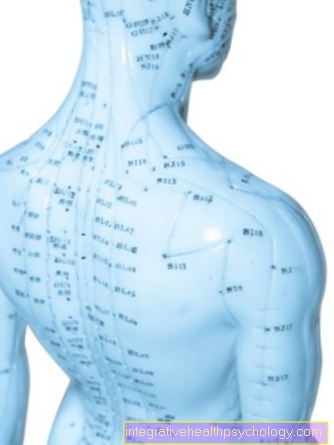Ulcerative colitis
Synonyms in a broader sense
Ulcerative colitis, colitis, Chronic Inflammatory Bowel Disease (IBD), ulcerative enterocolitis, ileocolitis, proctitis, rectosigmoiditis, proctocolitis, pancolitis, backwash ileitis.
Definition of ulcerative colitis
Ulcerative colitis belongs like that Crohn's disease to the group of inflammatory bowel disease (IBD). The isolated colitis is characteristic of ulcerative colitis Inflammation of the Colon and rectal lining. Ulcerative colitis is mostly associated with bloody, slimy diarrhea (diarrhea) and stomach pain symptomatic (discomforting) and affects preferentially younger people in the 2nd to 4th decade of life.

frequency
Out of 100,000 inhabitants, 40-80 suffer from ulcerative colitis, with an increase in the incidence rate over the past 20 years. The disease affects women only slightly more often than men and usually begins at a young age, between the 20 and 40 years of age. A second peak of illness is recorded between the ages of 60 and 70. One recognizes in part family and ethnic clusters. Ulcerative colitis is far more common in western countries than in underdeveloped countries. Whites are 4 times more likely than blacks and Latin Americans.
It is not uncommon for children to be affected. With them it is particularly severe because the classically occurring strong, frequent ones Diarrhea to a weight loss and a Lack of supply with stunted growth can lead. It is therefore important for young patients to take a break between attacks balanced, high-calorie diet to strive.
causes

A definitive cause of ulcerative colitis is not known. One assumes a multifactorial process, which means that several factors must come together for this disease to break out. A combination of genetic, immunological, infectious, nutritional, environmental and hygienic factors is assumed. The presumed mechanism seems to be a reduced tolerance to the physiological bacteria that colonize the intestine, so that antigens (foreign substances) that pass through the intestinal wall can cause an inadequate immune reaction. Ulcerative colitis is not regarded as a psychosomatic disease, but psychosomatic coincidence can trigger relapses and maintain the disease.
It is also assumed that a very low-fiber diet can contribute to the development of ulcerative colitis. Some ingredients, especially proteins from cow's milk, are suspected of promoting this chronic inflammatory bowel disease. In support of this theory, there are studies that show that people who were not breastfed by their mother in infancy have a higher risk of developing the disease than a comparison group.
More information on this topic: Causes of ulcerative colitis
Course and localization
Ulcerative colitis always begins in Rectum (rectum) and can move from there to the whole Large intestine spread. About half of the patients will only get that Sigma (penultimate part of the intestine; see Large intestine) and a further 40% affect the entire colon. In rare cases, it can also lead to a "washed in" inflammation of the small intestine; these are also called backwash ileitis.
Most of the time, ulcerative colitis occurs in stages, so that there can be pauses for years between the inflammatory attacks (Remission). A distinction is made between light, moderate and severe attacks.
- Light thrust: The general condition of the person concerned is not impaired. There is no fever and the bloody, slimy diarrhea "only" occurs up to five times a day.
- Moderate thrust: There may be a slight fever, diarrhea come up to eight times a day and are accompanied by cramp-like abdominal pain.
- Heavy thrust: It is characterized by slimy, bloody bowel movements that occur more than eight times a day. There is also a high fever over 38 ° C, an accelerated one Heart rate (Tachycardia), a tender stomach and a severely limited general condition.
An acute episode of the disease lasts on average about 4 to 8 weeks. In 10% of patients, however, one occurs despite adequate therapy chronically active course, without a remission being recorded. One then speaks of one therapy-resistant course.
With appropriate Medication one can only treat the symptoms of the disease and reduce the frequency and severity of acute attacks, but they do not cure them. This disease can only be really cured by one complete removal of the colon. However, this step should not be taken lightly, as the operation carries some risk of complications and in any case temporarily, in some cases even permanent, results in faecal incontinence, which is a great psychological stress on many patients.
Symptoms
In ulcerative colitis, a distinction is made between the very typical symptoms, which can be traced back directly to the inflammatory process in the intestine, and the so-called "extraintestinal" symptoms, i.e. those that are noticeable outside the intestine.
- Diarrhea: This is usually slimy and / or bloody and can occur up to 30 times a day. Combined with the diarrhea or in isolation, cramp-like pain occurs, typically in the left lower abdomen. As a result of these frequent diarrhea, many patients lose weight significantly. Since vitamins and nutrients can no longer be absorbed to a normal extent, deficiencies sometimes occur. The loss of blood (in some people with bowel movements, there is bleeding in the intestine regardless of their bowel movements) can also lead to more or less anemia.
- Flatulence: Some patients with ulcerative colitis also experience increased flatulence. Although these are not quite typical of the clinical picture, they still occur more frequently than in healthy people. Flatulence is to be taken seriously in sick people because they can increase the frequency of the stool evacuations, which are already so often necessary, or give an affected person the uncomfortable feeling of having to evacuate again, although sometimes it is not possible to precisely differentiate whether only intestinal gases have to escape or whether a thin diarrhea has to be discontinued. It is therefore also important that such patients in particular take care not to consume any / not too many flatulent foods.
- Nausea: Patients with ulcerative colitis are often plagued by nausea in the flare-up. Although this is not one of the main symptoms, it is not uncommon for it to come in combination with the bloody, slimy bowel movements and the cramp-like abdominal pain (Tenesmen) in front. In the normal case, however, the patient does not actually have to vomit. Often, however, the nausea is accompanied by a loss of appetite, which must be taken seriously, since those affected lose a lot of weight anyway due to the frequent diarrhea.
- Joint pain: In ulcerative colitis, a distinction is made between the typical symptoms associated with the intestine and the so-called extraintestinal symptoms, i.e. those outside the intestine. These symptoms also include joint pain. These are caused by joint inflammation and can sometimes be associated with restricted mobility. As a rule, the larger joints, for example the knee joint, are more likely to be affected. In such a case, the joint pain usually comes along with an acute flare-up and disappears again when it subsides. If, on the other hand, smaller joints are affected, they often remain permanent, regardless of the level of activity of the ulcerative colitis. Joint involvement does not occur very often in the collective as a whole, but it can severely impair the patient's daily life and can even be perceived as worse than the actual disease, at least if it is really permanent.
- Other extraintestinal symptoms: This group mainly includes skin changes (for example aphthae or typical looking redness, the Erythema nodosum), Inflammation of the eye (iris or choroid) or inflammation of the liver (primary sclerosing cholangitis, PSC).
Also read the article on the topic: Pyoderma gangrenosum
Read more about:
- Blood in the stool - these are the causes!
- Blood in your stool and stomach pain
- Fever, increased tiredness and reduced performance, a racing heart and an increase in white blood cells are also caused by the inflammation in the intestine and the body's reaction to it.
- Vomiting of blood: In the context of ulcerative colitis, vomiting of blood rarely occurs. Since ulcerative colitis is more likely to manifest itself in the lower digestive tract, this symptom is rare.
Read more about this on our website Symptoms of ulcerative colitis.
Pain in ulcerative colitis
About 80% of all patients with ulcerative colitis have it pain during flare-ups, around 20% of those affected but also during the relapse-free period.
The most common are Abdominal pain in the left lower abdomen, they often occur during or after a bowel movement. Then there are the Pain from inflammation outside the bowel, for example in the joints.
Painkillers can provide relief, but they should only be taken in consultation with the treating doctor, as some common and over-the-counter painkillers can trigger or worsen relapses (e.g. ibuprofen).
Flatulence as a symptom - what can you do about it?
Flatulence is a common symptom of ulcerative colitis and can be very stressful for those affected.
Too much gas in the bowel leads to loud bowel noises, abdominal pain and possibly noisy escape of the gases. In severe cases, the belly inflates visibly ("bloated stomach").
In addition, the gases trapped in the intestines can exert pressure on organs above the intestines, causing belching, loss of appetite and nausea. The gases either enter the intestine from outside, for example by swallowing more air while eating, or they are increasingly produced in the intestine. The latter is often the case with ulcerative colitis, among other things because the natural intestinal flora can be disturbed by the disease.
Flatulence often improves as disease activity decreases, which is why treatment of ulcerative colitis is the most important measure to reduce intestinal gases. It can also help to eat more slowly and consciously to avoid swallowing too much air. Diet itself also has an impact on gas production in the intestines, fiber-rich foods and carbonated drinks should be avoided if you have flatulence. Probiotics (for example Kijimea® preparations) or home remedies such as teas made from fennel and caraway seeds can also reduce the symptoms.
Read more: Kijimea® irritable stomach
Relapses in ulcerative colitis
Ulcerative colitis is a chronic inflammatory bowel disease, as is Crohn's disease. The disease is characterized by the fact that it usually consists of phases without complaints and acute phases with complaints. These phases in which those affected suffer, among other things, from very frequent and pronounced, often bloody diarrhea and abdominal pain, are called relapses. This means the occurrence of a disease flare-up after a period of rest.
However, there are also patients who permanently suffer from symptoms of the disease, which is referred to as a chronically active course. Treatment of ulcerative colitis often consists of long-term medication and acute medication, which is used when an acute flare-up occurs. Long-term medication is intended to contain the disease activity as much as possible, while relapse medication is primarily used to rapidly reduce symptoms.
Often, however, it is not possible to completely control symptoms with medication. There may be times when the symptoms are so severe that hospital treatment is required during an attack. Here certain medications can be administered intravenously as infusions, this often leads to faster relief than taking the medication in tablet form.
You can find more information about this on our website
- Ulcerative colitis flare-up
- Therapy for ulcerative colitis
- Mesalazine
Diagnosis of ulcerative colitis

The Diagnosis of ulcerative colitis is through Blood tests and especially the Colonoscopy, including the tissue (histological) Examination of a mucous membrane sample provided. The most important differential diagnosis is Crohn's diseasewhich is very similar to ulcerative colitis, especially in terms of symptoms. In 10% of patients with nonspecific colitis, the definitive diagnosis cannot be made at the beginning of the disease.
in the Doctor-patient conversation (anamnese) the stool frequency, stool quality, blood, Pain and other symptoms are asked. The physical examination often does not give any specific findings. Sometimes you can feel a tender stomach and with the rectal palpation examination Find blood on the glove.
When doing a blood test, some parameters may indicate inflammation in the body.The Sedimentation rate (BSG) accelerates that C-reactive protein (CRP) be increased and an increased number of white blood cells (Leukocytes) being found. A humiliated one Hemoglobin level in the blood (anemia) may be caused by loss of blood. About half of the patients can have one in their blood Autoantibodies find the so-called prinuclear antineutrophic cytoplasmic antibodies (p-ANCA). In order to be able to partially exclude other diseases that can occur in the abdominal cavity, a Sonography of Abdomen (Abdomen) performed. An important diagnosis of exclusion is an infectious cause for the intestinal inflammation (colitis), which is also with diarrhea goes hand in hand. Therefore, sometimes a Stool examination (Stool sample) to be able to exclude particularly bacterial pathogens as a cause.
However, the most important diagnostic measure is that Colonoscopy.
Colonoscopy (colonoscopy):
The "mirroring" (Endoscopy) of the intestine is the diagnostic tool of choice for the direct assessment and classification of damage to the mucous membranes and should be carried out if a chronic inflammatory bowel disease is suspected. In the Colonoscopy will have a Hose camera (endoscope) Transferring images to a monitor. For this purpose, the camera is pushed forward to the cecum (part of the large intestine) and then the mucous membrane is assessed while slowly withdrawing it. During the colonoscopy you can additionally Tissue samples (biopsy) can be taken from inflamed areas of the mucous membrane. The fine-tissue assessment of the biopsies under the microscope (histological finding) is far more meaningful than the (macroscopic) findings recorded with the naked eye.
Read more about the topics here Endoscopy and biopsy
When examining the intestinal mucosa, depending on the severity of the inflammation, a simple one swelling (edema) of the mucous membrane, up to large areas Ulcers with massive Bleeding and Loss of the mucosal relief on. Sometimes it can be done in endoscopy Pseudopolyps which arise from excessive healing reaction (regeneration) of the mucous membrane.
Rectoscopy (recto-sigmoidoscopy):
This method enables the rectum to be viewed through a rigid tube. With an isolated inflammation of the Rectum (rectum) you can use this method for Follow-up to use. However, a complete colonoscopy should always be performed for the initial diagnosis.
Histological examination:
The biopsy taken in the endoscopy should be viewed by the pathologist under the microscope fine tissue (histologically) to be examined. Often ulcerative colitis can be distinguished from other intestinal inflammations, such as Crohn's disease, through the characteristic mucosal involvement. A characteristic microscopic feature of ulcerative colitis infestation of the large intestine is an isolated inflammation of the mucous membrane (mucosa). This shows a strong one Enrichment of inflammatory cells (Lymphocytes) in the mucosa and a strong reduction in those typical of the large intestine Goblet cells. Considered to be particularly characteristic Abscesses in the crypts the lining of the colon (see also anatomy Large intestine).
Colon contrast enema:
In the case of colonic enema, the large intestine is exposed to contrast medium via the anus (enema, enema, Clysma) in the X-ray image made visible. In addition, you can inflate the intestine with air so that the contrast agent is placed on the walls of the intestine and so even the finest changes in the intestinal wall become visible. Inflammatory intestinal wall diseases such as ulcerative colitis and the constrictions associated with it are easy to assess (Stenoses, Strictures) possible.
Sometimes an MRI according to Sellink is also done. Here is the MRI of the abdomen carried out after oral administration of contrast media using the Sellink technique. Diseases of the small intestine in particular can be diagnosed well using this technique.
How is ulcerative colitis treated?
Ulcerative colitis is usually treated with medication. As already described above, a distinction is made between two types of medication. Those that are given permanently to reduce disease activity (Maintenance therapy) and those that are given when a flare-up occurs in order to alleviate the symptoms as effectively as possible.
A distinction is made in the drugs used between those that have anti-inflammatory effects and those that have an immunosuppressive effect. The latter are supposed to downregulate the body's own immune system, as it is often excessively active in ulcerative colitis.
There are drugs that can be taken in tablet form and those that should work as locally as possible, here rectal enemas or suppositories are used. Painkillers are also often necessary in the treatment of ulcerative colitis.
In severely affected patients, in whom medication does not provide sufficient improvement, and in patients who have developed complications, surgery can also be considered as a treatment option. This is possible because ulcerative colitis only affects the large intestine but not the small intestine. So the large intestine or parts of it can be surgically removed. This is a relatively complex operation, as the intestinal passage has to be restored by remodeling and reconnecting the small intestine.
Read more about this on our website Therapy of ulcerative colitis and Mesalazine
What drugs are there for treating ulcerative colitis?
The goal of drug therapy for ulcerative colitis is always remission, i.e. ending the disease flare-up. It is not possible to cure the disease with medication alone. Which medication is administered depends on the severity of the symptoms.
In general, mesalazine (5-ASA, trade name e.g. Salofalk) is used for light to moderate attacks. Depending on which parts of the large intestine are affected, either in the form of suppositories, purchases or foams or as a tablet. Treatment is continued for at least two years after the end of the attack to maintain remission.
The bacterial strain E. coli Nissle (trade name Mutaflor) can also be used as an alternative in the event of intolerance.
In the case of more severe attacks or failure of mesalazine, cortisone preparations are used, which should only be used for a short time due to their side effects. If there is no response, the immunosuppressants tacrolimus and ciclospoprin A are still available.
In special cases, if the therapy fails further, the TNF-alpha blockers adalimumab, infliximab and golimumab are used.
In chronically active colitis, azathioprine or 6-mercaptopurine is also used, a so-called immune modulator that weakens the body's immune reactions. However, this medication will not work for three to six months after you start taking it.
The integrin antagonist vedolizumab (trade name Entyvio) has only been approved for the treatment of ulcerative colitis since the beginning of 2014.
Read more on the subject at: Drugs for ulcerative colitis
Cortisone, used to treat ulcerative colitis
Cortisone preparations are among the in ulcerative colitis Standard drugs.
For mild to moderate attacks, they are often used in local form, for example as an enema or suppository. At heavier Relapses often also have to occur systematic administration of cortisone can be used, i.e. in the form of tablets or intravenously. With this form of application, in particular, the risk of the typical side effects of cortisone (e.g. increase in blood pressure, weight gain, water retention in the tissue, increase in blood sugar, etc.) is high with long-term use, which is why cortisone is usually avoided with long-term drug administration.
Treatment with Humira
Humira® is an active ingredient from the group of biologicals. It contains the active substance adalimumab. This is an antibody against a signal substance that plays an important role in the body's own inflammatory processes. The antibody is supposed to reduce their activity and thus curb the inflammatory processes.
Humira® is used as a subcutaneous syringe, i.e. it is injected into the subcutaneous fat tissue. This is usually necessary every two weeks.
Humira® is used in ulcerative colitis when all other medications have not brought about sufficient improvement and when the disease is severe or moderately severe. Humira® is a very expensive drug, a syringe costs just under 1000 euros.
Treatment of a nudge
Come to treat an acute flare-up of ulcerative colitis anti-inflammatory drugs for use. Two in particular should be mentioned here: Mesalazine and drugs from the group of corticoids / steroids. Mesalazine can be used as Suppositories, Rectal foam or tablet be taken depending on which part of the colon is affected.
If therapy with mesalazine is not sufficient, steroids such as Budesonide for use. This can also be administered rectally for local use. If this is not enough, you can Prednisolone tablets can be used. Long-term therapy with steroids such as prednisolone or budesonide is usually avoided because of numerous side effects that can occur after prolonged use.
If steroids have been taken for several weeks, it can usually no direct settling instead, the medication must be tapered off. This means that the dose is gradually reduced until the drug can be stopped completely. If it is a severe acute episode, a Treatment in hospital become necessary. Here the steroids can be administered via the vein, this often leads to a faster and more effective effect.
Chances of recovery in ulcerative colitis
The drugs that are used in the treatment of ulcerative colitis can only treat the symptoms of the disease and reduce the frequency and severity of acute attacks, one cure however, cannot be achieved with them.
This disease is really curable only through a complete one Removal of the colon.
However, this step should not be taken lightly as the surgery does some Risk of complications and also in any case temporarily, in some cases even permanently Fecal incontinence which causes a lot of psychological stress on many patients.
Complications
In the case of severe attacks with severe blood loss, a life-threatening situation can sometimes arise that necessitates a blood transfusion or, in extreme cases, even an emergency operation.
Read more on the topic: Blood transfusion
Another dreaded complication of ulcerative colitis is the toxic megacolon. If the inflammation spreads to the intestinal nervous system, it can lead to intestinal paralysis (intestinal paralysis; ileus) and thus to a stretching of the intestinal wall (intestinal dilatation). As a result of the intestinal dilatation, the intestinal bacteria can pass quickly through the intestinal wall and thus develop life-threatening peritonitis (peritonitis). Peritonitis is a severe inflammation that can quickly lead to life-threatening blood poisoning (sepsis) and shock with circulatory failure. In addition, with this complication there is a risk of an intestinal perforation, which must be treated surgically as quickly as possible. The onset of a toxic megacolon manifests itself in severe abdominal pain (acute abdomen), tachycardia, fever and interruption of the initial diarrhea (ileus). If the intensive care supply with antibiotics (bacteria-killing drugs) and glucocorticoids (cortisone; strong anti-inflammatory effect) remains unsuccessful, the affected section of the intestine must be surgically removed (resected).
After years of ulcerative colitis, changes (dysplasias) can occur in the mucous membrane, which can easily degenerate into colon cancer (colon carcinoma). If the entire colon (pancolitis) is affected over a period of 20 years, the risk of degeneration into a malignant tumor is around 50%. There is therefore an evident prevention plan for cancer prevention that should be implemented consistently. For this purpose, a preventive examination by means of a colonoscopy is carried out once a year for pancolitis after 8 years of illness and for left-sided colitis after 15 years of illness.
Read more on the topic: Colon cancer
Diet in ulcerative colitis
In ulcerative colitis, diet plays an important role in two aspects of the disease, namely on the one hand in the context of the development and in the context of the therapy of this disease.
Why ulcerative colitis really occurs has not yet been definitively clarified.
However, we now know that there are many factors that are important for the development, this is also known as multifactorial genesis.
In addition to a disturbed immune system, bacteria / viruses, the structure of the natural intestinal flora, a hereditary disposition and psychosomatic causes, these factors also include diet.
For example, it is assumed that a very low-fiber diet can contribute to the development of ulcerative colitis.
Some ingredients, especially proteins from cow's milk, are suspected of promoting this chronic inflammatory bowel disease.
In support of this theory, there are studies that show that people who were not breastfed by their mother in infancy have a higher risk of developing the disease than a comparison group.
An important part of the treatment of ulcerative colitis is an individually designed nutrition plan, which can vary from patient to patient.
In principle, those affected are allowed to eat what is good for them.
In general, a diet high in vegetables, fruits, fiber and protein and low in fats, meat and alcohol has prevailed.
For some patients, avoiding dairy products or soft drinks has proven beneficial. Often it is also important to ensure that the food has a sufficiently high calorie content, because patients often lose massive weight due to frequent diarrhea.
In a severe acute episode, normal food intake can become impossible for a patient with ulcerative colitis. In such a case, it is necessary to change the diet to an artificial diet that does not have to go through the intestines, i.e. so-called parenteral nutrition. This can get into the body through the vein, for example.
Smoking in ulcerative colitis
A much discussed point about ulcerative colitis is that Smoke.
In conclusion, no statement can be made about the effects of smoking on ulcerative colitis.
While one at the similar other inflammatory bowel disease, the Crohn's disease, meanwhile knows for sure that smoking is a serious risk factor for its development, this has not yet been proven in ulcerative colitis.
On the contrary, there are even studies that show that non-smokers and ex-smokers get sick more often than active smokers.
A cause for this has not yet been found. As a prevention, however, is no smoking indicatedas this can lead to a significant number of other illnesses.
How does alcohol affect the disease?
A recent study showed that 15-30% of all ulcerative colitis and Crohn's disease patients after drinking alcohol with severe diarrhea, Abdominal pain and gas Suffer. Nevertheless, as with coffee, no general alcohol ban can be issued for IBD sufferers.
Here, too, every patient should test for themselves how well alcohol is tolerated. That applies at least to low-proof spirits such as beer and wine. On the other hand, high-percentage alcohol such as schnapps should generally be avoided in chronic inflammatory bowel disease, as it can irritate the intestinal mucosa and trigger relapses.
What influence does coffee have on ulcerative colitis?
coffee can be used in ulcerative colitis Symptoms such as gas, Diarrhea and abdominal pain evoke or pre-existing aggravate.
Coffee can also be beneficial for some patients have a thrust-releasing effect. However, the tolerance of certain foods varies from patient to patient, which is why some people affected can drink coffee without any problems. So there is no general “ban” on coffee for ulcerative colitis. Rather, each patient should try out for himself whether and to what extent he can tolerate coffee.
What is the life expectancy with ulcerative colitis?
In general, inflammatory bowel diseases such as Crohn's disease and ulcerative colitis have only a very small or no negative impact on life expectancy.
Those affected usually live as long as healthy people. This applies as long as the disease is treated by a specialist and the medication is properly adjusted, otherwise serious and potentially fatal complications can arise. It is therefore important for those affected to take their own treatment seriously and to take the prescribed medication as directed by the doctor.
Read more on this topic at: Life expectancy in ulcerative colitis
Crohn's disease and ulcerative colitis - what are the similarities?
Both diseases are among the inflammatory bowel disease, CED for short, a genus of systemic autoimmune diseases that primarily manifests itself in the digestive tract. Accordingly, in both diseases the resulting symptoms such as diarrhea, abdominal pain and flatulence are in the foreground.
However, the exact localization of the inflammatory process differs. By definition, ulcerative colitis only affects the Large intestine and here the last sections are preferred. Only in very rare cases is the end of the small intestine also affected. In addition, only the lining of the large intestine is affected by the inflammation.
Crohn's disease however, manifests itself frequently throughout the digestive tract, from the esophagus to the rectum. In addition, the entire intestinal wall is usually involved in the inflammatory process. The course of the disease is also very similar, because both ulcerative colitis and Crohn's disease progress in stages - that is, phases of high disease activity alternate with phases of low or no disease activity.
The is designed accordingly drug therapy very similar. Both patients are mainly treated with aminosalicylates (e.g. mesalazine), cortisone preparations (e.g. budesonide), immunomodulators (e.g. azathioprine) and biologicals (e.g. infliximab). Neither of the two diseases can be cured with medication, but ulcerative colitis can be cured by removing the entire colon.





